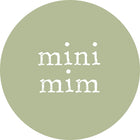Did you know that each colour has a different impact on children's behaviour?
At Mini Mim, we dedicate ourselves to create designs that are not only fun and inspiring but we also believe that colour can be a key tool for children's learning and development.
This is why you will see in all of our illustrations colours that we know have a positive impact on your children!
Many studies have shown that colour has a profound effect on our emotions, mood, and behaviour, and understanding how they affect children can help us create nurturing and stimulating environments.
For example, did you know that when kids are exposed to their favourite colour it boosts their mood and makes it easier for them to learn?
Understanding how each colour can affect a child's mood and development is part of our design process in order to improve your child abilities to learn!
Let's take a look at some colour that we use in our design and what they mean:

ORANGE:
Orange is a vibrant colour that leads to happiness and enthusiasm. When your child is exposed to some orange, for example, early in the morning, it helps them feeling more awake. It is also a colour that help them engage with their peers more.
PURPLE:
Purple is often one of the favourite colour for children as it is very eye-catching. It can contribute to a child’s creativity and overall well-being. Also interesting, as it has a calming effect. Take lavender, for example, a calming and peaceful plant! This colour is also perfect for improving a child’s imagination and emotional development, both in the classroom and at home.

GREEN:
Green is known to improve a child's concentration and helping them with reading comprehension. It has a calming and healing properties. This is why we thought incorporating green in our backpack is important to help manifest those benefits. Green is also connected to nature and outdoor environments which invite the child to have a special appreciation for nature.
BROWN:
Brown is probably not the most favoured colour for kids, but adding it to our colour scheme brings some warmth. This colour is known to make kids feel safe and encourage them to build solid friendships, leading to help kids come out of their shells more. This relaxing colour is really beneficial as well as it keeps them feeling down-to-earth, which helps them succeed in all areas of life. Plus, combined with some other colour, kids also get the creativity they need.
YELLOW:
Yellow often brings a sense of joy, happiness and laughter when kids are exposed to it! When yellow is present, kids can concentrate better and is a good tool to improve their memory. It is also important not to over use this colour as it can lead to other emotions such as frustration or anger, but just some tint of it makes its real effects!
We hope that these information have interest you and help understanding how colour have a significant impact on children's behaviour and emotions.
By carefully selecting and incorporating colour in their surroundings, we can promote positive behaviour, creativity, and a sense of harmony for children as they navigate the world around them. Let's embrace the power of colour and use them to shape nurturing and stimulating environments for our children's growth and happiness.

